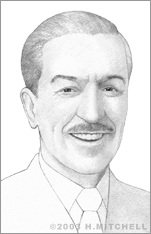Walt Disney
Walt Disney, creator of Mickey Mouse and the Disney Studios empire, was born Dec. 5, 1901 in Chicago. He was raised on a farm in Missouri and was sketching by age five, selling his drawings to neighbors by the age of seven. At the age of 16, he tried to enlist in the military but was rejected because he was too young. Instead, he joined the Red Cross and was sent overseas, where he drove an ambulance that he covered with cartoons.
When Disney returned, he began a career as an advertising cartoonist in Kansas City, where he created and marketed his first original animated cartoons in 1920. He decided to make a break for Hollywood in 1923 and left with just $40 in his pocket to join his brother, Roy, there, where the two created an animated mini-feature in their uncle’s garage. They soon had their first production order and started up their studio in a Hollywood real estate office. Walt married and had two daughters, and in 1928, he created Mickey Mouse, who starred in the world’s first fully-synchronized sound cartoon, “Steamboat Willie,” in 1928.
In 1934, Walt first presented his idea for the movie “Snow White and the Seven Dwarves.” He had a vision for a groundbreaking, color film with a realistic mood. That meant he would have to find a way to overcome one of animation’s greatest challenges at the time – conveying the illusion of “depth.”
The solution would lie in his creation of the multiplane camera. Typically, animation cells had been placed in layers directly on top of a background as each frame of film was exposed. This created challenges such as shadow effects, lighting effects, color shifts, and perception of distance in a scene, especially when a character was moving forward or backward. Together with William Garity, who was head of the Disney Camera Department at the time, and Roger Broggie, Walt tested several models of the multiplane camera with techniques used in live theater staging in mind.
In theatre, cutouts and flat pieces are placed in varying layers against a backdrop, allowing actors to move through the sets and create the feel of depth. The final design for the multiplane camera was based on this same concept. The camera itself would shoot down through up to five planes attached to vertical posts that allowed four of the planes to move independently of one another. The first two planes were used for animation, the next two were for backgrounds, and the fifth was fixed and used for sky backgrounds. Since each shot required a great deal of testing to get perspective, timing, and overall look right, it was very expensive and time-consuming to use the system. This led Disney to use the camera only for feature films.
The results, however, spoke for themselves. Using the camera, the Walt Disney Company created “The Old Mill,” for which they won an Academy Award, as well as a Technical Award. In 1937, “Snow White” became a reality. This was the first full-length feature animated film to use the camera. U.S. patent #2,201,689 was granted to Disney for the "art on animation" camera on May 1, 1940.
Walt Disney died in 1966, after earning more than 30 Academy Awards and a number of honorary degrees and other honors, including the Medal of Freedom, presented by President Lyndon Johnson, and his induction into the National Inventors Hall of Fame. During his lifetime, the studio released 81 features. Eventually the multiplane camera became obsolete, with the advent of digital animation technology, expecially the CAPS system (the studio's Computer-Aided Production System), developed largely by Pixar.


